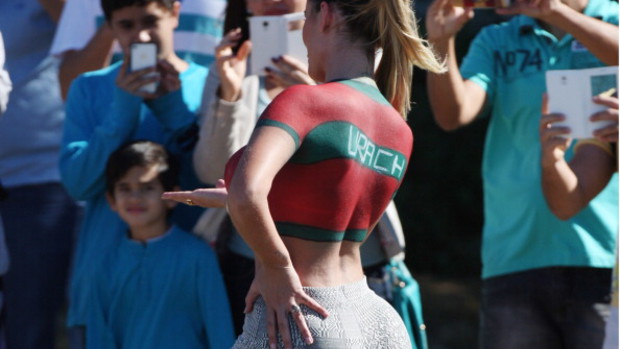Plastic surgery turned toxic in Brazil

By Bloomberg View
This time last year, Brazilian beauty contestant Andressa Urach was on a tear. Wherever bright lights shone, the fair, flaxen and preternaturally curved Urach was near, wearing little more than a smile or body paint (as she did during the World Cup), winning the runner-up slot to Brazil's vaunted Miss Bum Bum contest, 228,000 followers on Twitter (and nearly 500,000 on Instagram) and drawing throngs of "Urachettes" every time she flew into an airport.
Last month, however, the 27-year-old beauty icon entered a hospital isolation ward, battling a massive infection. In her climb to glory, Urach had undergone serial cosmetic surgery, cantilevering her torso into shapes that Jeff Koons never imagined. In the process, however, she pumped her body with toxins that have made her a cautionary tale about the pursuit of accessorized posterity in a culture where you are what you implant.
She is not alone. In 2013, Brazil hip-checked the U.S. to claim first place in global plastic surgeries, performing 1,491,721 cosmetic operations to the U.S.'s 1,452,356. (The U.S. still leads in total procedures, including non-surgical cosmetics such as Botox injections.) The country is a prime destination for medical tourism and, thanks to tradesmen like the storied Ivo Pitanguy, something of a finishing school for surgeons. Rio de Janeiro hosted last year's annual gathering of plastic surgeons, touted in a leading trade rag last July under the coverline "We Are the World."
Brazil also bore the brunt of the 2012 breast implant scandal that saw 300,000 women across 65 countries (14,000 in Brazil alone) insert tainted, industrialized silicone implants into their bodies, touching off an international medical emergency.
That barely dented the queue at Latin American cosmetic refab clinics. Latin America boasted five of the top 10 countries for cosmetic surgery in 2013, the latest figures from the International Society of Aesthetic Plastic Surgery. Together, Mexico (third place), Colombia (fifth), Venezuela (sixth) and Argentina (ninth) accounted for nearly one in 10 cosmetic operations worldwide.
The gluteal implant is credited to a Mexican physician, and Argentines are as conversant in scalpel sculpture as they are with the psychiatrist's divan. "Mankind suffers two great ills, aging and ugliness," the noted Buenos Aires surgeon Jose Juri once told me. "Plastic surgery can treat them both."
How Brazil became the axis of overhaul is passing strange. The country was born when Europeans comingled with Africans and indigenous folk, a combination that gave its scions a rainbow of complexions and a New World breadth of beam. For half a millennium that was fine with the locals, who reveled in "dental floss" bikini britches and fondly, if piggishly, referred to the object of their admiration as "the national preference."
But DNA is no longer destiny. Thanks to the wonders of industrial polymers, a buyer's medical market and the rise of the middle class, almost anyone can indulge in a remake. Brazilians can even write off a boob job or a new nose on their income taxes. That set of circumstances has also created an opening for legions of quacks and cooks, who flog or flaunt glory by the liter. Ask patient Urach.
Here we are to serve you with news right now. It does not cost much, but worth your attention.
Choose to support open, independent, quality journalism and subscribe on a monthly basis.
By subscribing to our online newspaper, you can have full digital access to all news, analysis, and much more.
You can also follow AzerNEWS on Twitter @AzerNewsAz or Facebook @AzerNewsNewspaper
Thank you!
